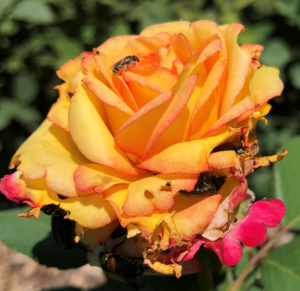Battling Japanese Beetles
- 2019-07-03
- By danibash
- Posted in The Garden Buzz
By Lisa Mason
This invasive beetle has two unique challenges: 1) Japanese beetles cause damage during the larval/grub stage in turf grass, and adults cause damage by feeding on a variety of landscape plants and trees, and 2) adult beetles feed on blooming flowers at the same time pollinators and beneficial insects are pollinating those flowers, which limits control options.
Japanese beetles appear around mid-June, but now is the time to start planning for their return. Here are some things you can do:
- Keep your plants as healthy as possible. A healthy plant will be able to sustain more damage. Practice good cultural care to reduce stress on your plants.
- Keep turf as healthy as possible, too. A strong root system will be able to tolerate more feeding from grubs.
- Be creative with plant selection! Evergreens, annuals, perennials, some vegetables, and many tree varieties are not susceptible to the beetle. Research which cultivars are not susceptible to Japanese beetles.Research control options:
- Choices can be limiting depending on if pollinators are foraging on the same flowers that the Japanese beetles are feeding on. Pollinator-safe options include Bacillus thuringiensis galleriae (marketed as beetleGONE!, beetleJUS!) and chlorantraniliprole (marketed as Acelepryn SC).
- Look for plants that do not produce flowers or their flowers bloom at a different time than when the adult beetles are active. For example: crabapple trees bloom in the early spring when adult beetles are not active and other treatments may be an option.
- Remember the label is the law! If you chose to apply pesticides, the directions must be followed exactly.
- For a complete list of control options on foliage and turf and how they affect pollinators, see the Japanese Beetle fact sheet.
When the beetles arrive:
- Hand-pick Japanese beetles to your hearts content! You can squish them or dump them in a bowl of soapy water. This effort may seem tedious, but keep in mind each female beetle can lay 40-60 eggs. Hand-picking will also reduce the volatile attractants produced by plant wounding.
- Think twice before using Japanese beetle traps. Research shows that traps can attract more beetles to the area. If you choose to use traps, place them at least 30 feet from any vegetation that the beetles will eat.
- Make sure you have grubs in your turf before treating the turf with products. Checking can save you time and money. Grub damage looks very similar to other turf issues. Try doing a “tug test”. If you tug on your turf and the grass pulls out of the ground immediately, then you have may have grubs that have been feeding on the roots. If the grass is rooted into the ground, you may have another issue.
- If you do have grubs, consider drying out the lawn when the grubs are active. They need well-irrigated soil to survive.
More questions on Japanese beetle? Call CSU Extension in Arapahoe County or visit Arapahoe.Extension.Colostate.edu.
Best of luck battling the beetles this summer!
Horticulture Resources
- Garden Buzz Archives
- CSU Extension Resources
- Colorado Master Gardener Program
- Foothills to Plains Native Plant Master Program
- Native Bee Watch Community Science Program
- The Co-Hort Blog
- PlantTalk Colorado
- Soil Testing
- Plant Select
- Emerald Ash Borer
- Japanese Beetle
- Colorado State Forest Service
- Ask an Expert




